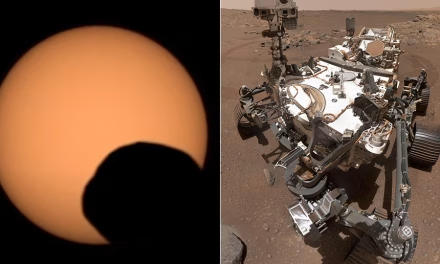A new study in Nature suggests that asteroid Ryugu once carried liquid water deep inside it. The finding comes from tiny rock grains gathered by JAXA’s Hayabusa2 spacecraft, and it’s making scientists rethink how water moved around the early Solar System.
On the surface, Ryugu looks like a dry, rubble-pile space rock shaped like a giant space pieirogi.
But when researchers at the University of Tokyo analyzed the material, they found chemical fingerprints that didn’t line up with expectations. The isotope pairs of lutetium and hafnium—normally a reliable way to date rocks—came back showing ages older than the Solar System itself.
That’s impossible.

The team’s lead scientist, Tsuyoshi Iizuka, explained that something had “reset the clock” in Ryugu’s samples. The best explanation is that fluids once seeped through the rock, disturbing those isotopes and leaving chemical evidence that water had flowed there. As Iizuka put it, “the water hung around for a long time and wasn’t exhausted so quickly as thought.”
So what thawed that ice? The researchers suspect a collision. When another body slammed into Ryugu’s parent asteroid, the shock would have fractured the rock and released buried ice. The resulting heat could have melted it, creating pulses of liquid water that trickled through the rock. The same impact may also have shattered the parent body, with Ryugu forming from the debris.
What surprised the researchers most is just how long the water activity lasted. Ryugu preserves a record of fluids moving through its rocks far later than anyone expected. That stretches the timeline for water in asteroids well beyond the earliest days of the Solar System, suggesting that small bodies like this could have stored and released water much longer than we thought.
If asteroids like Ryugu held ice for billions of years, they might have delivered far more water to the young Earth than earlier theories allowed. Instead of only tiny amounts trapped in minerals, carbon-rich asteroids could have been steady suppliers, helping to build Earth’s oceans and atmosphere. “The idea that Ryugu-like objects held on to ice for so long is remarkable,” Iizuka said. “It suggests the building blocks of Earth were wetter than we imagined.”
The Hayabusa2 samples are no larger than grains of rice, yet they carry clues this profound. Scientists are now focusing on phosphate veins within the material to pin down the timing of water flow more precisely.
And the story isn’t over. NASA’s OSIRIS-REx mission has returned its own cache of material from asteroid Bennu. Comparing Bennu to Ryugu could show whether this watery history is unique, or whether asteroids across the Solar System shared the same story. If the latter proves true, then these humble rubble piles may have played a much larger role in making Earth habitable than we ever realized.
![]()
SCIFI.radio is listener supported sci-fi geek culture radio, and operates almost exclusively via the generous contributions of our fans via our Patreon campaign. If you like, you can also use our tip jar and send us a little something to help support the many fine creatives that make this station possible.













I’m think space is not only the final frontier, it might have been the first frontier.